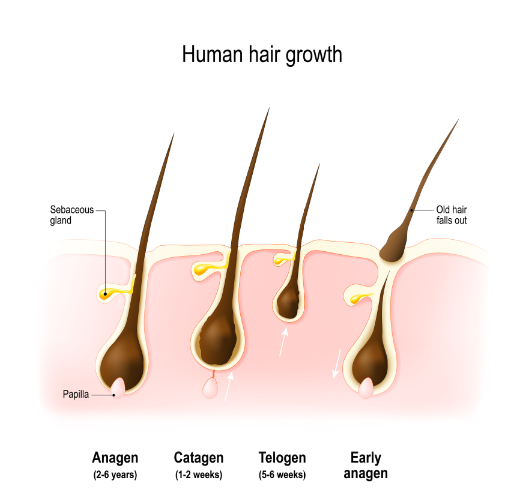By John C. Anderson Ph.D.

Introduction
Over 80 million Americans experience hair loss with as many as 25% seeing the first signs by the time that they are 21 years old. Hair loss has a wide variety of causes ranging from heredity and medical conditions to hormones, diet, stress and simply poor hair care practices. To match the range of causes, medical professionals have identified a range of solutions to address the causes.
The amount of hair loss and the percentage of people who experience it increases with age. So, while topical (minoxidil), oral (finasteride) and vitamin or botanical solutions often help arrest hair loss, some physicians have recommended alternatives to increase the growth cycle and to generate new hair growth in areas that have seen significant hair loss. One recommended procedure is PRP (platelet rich plasma) injections, with and without adult stem cells.
What is the PRP Procedure?
Our blood contains two different elements – red blood cells and plasma. The plasma contains white blood cells and platelets. Platelets are rich in growth factors. PRP has been used for decades to increase healing injured tendons, ligaments and muscles, for example in joints with arthritis and more recently to help increase collagen production in facial skin rejuvenation. PRP is a three-step process by which a small amount of a patient’s blood is drawn (Step 1) and put in a centrifuge. Spinning the blood allows it to be separated, obtaining the platelet rich plasma (PRP) (Step2). The PRP is then placed in a syringe and injected into the area of thinning hair (Step 3) at the level of the hair follicle. Combining the PRP with thrombin or calcium chloride results in the production of growth factors (cytokines). By performing multiple injections about one half an inch apart in the target area, the PRP stimulates growth of existing hair follicles and generation of new growth. Each hair follicle can have multiple hairs growing from it. The PRP increases blood supply to the hair follicle and increases the thickness of the hair shaft as a result.
The standard protocol is for this less than one-hour procedure to be performed once a month for three months initially and then once every four to six months to continue the growth cycle. Information from realself shows that 73% of patients believe that it is worth it. Research from India indicates that average increase in hair growth experienced was approximately 30%.
PRP with Adult Stem Cells
Recently, there has been more and more interest in the use of human adult stem cells in a wide range of treatments. One of the most promising has been in the field of hair restoration. The standard PRP protocol (described above) is augmented with adult stems cells derived from adipose fat. The doctor uses liposuction to extract 40 to 100ccs of adipose fat. This fat is then filtered to purify it and it is added to the PRP solution. The rationale behind this is that the purified fat contains adult stem cells that both provide energy for the new growth and reduce the concentration of androgens like testosterone in the tissue that may be limited growth. While this procedure is not currently FDA approved, a series of studies are currently underway to test the effectiveness of PRP with adult stem cells in hair restoration.
One of the benefits of PRP, with or without adult stem cells is that the procedure uses the patient’s own blood. This means that there is no risk of getting a communicable disease due to introduction of outside agents. It is important to note that there are some situations in which PRP may not be recommended including being on blood thinners, having acute or chronic infections or certain diseases.
Understanding the causes of your particular hair loss and identifying the stage of hair loss is very important in developing a treatment plan that can range from addressing the underlying cause (medical or hormonal) to topical or surgical alternatives. This includes determine whether or not PRP is appropriate in your situation. The doctors associated with the Capily Institute can help diagnose and treat all forms of hair loss, recommending the best strategy for hair restoration or replacement.















